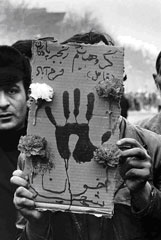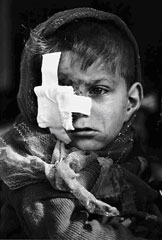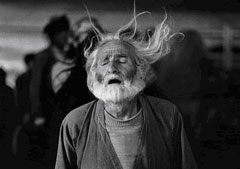Introduction
 Kaveh Golestan was the photojournalist with the longest continuous presence in Iran from before the Revolution until his death in 2003. This retrospective exhibition of his stark black and white photography covers the period from 1975 to the late 1990s, beginning with his iconic social realism of Tehran's disenfranchised. Golestan was an eyewitness to the Iranian Revolution and his photographs not only capture the major political upheavals that radically changed his country into an Islamic Republic; they are an intimate portrayal of a people and society in rapid transition. His photographs of Ayatollah Khomeini's arrival in 1979 and his riotous funeral a decade later were published in magazines and newspapers around the world. As Carlos Guarita wrote in Golestan's obituary published in the Independent newspaper, wars came to Golestan's door. He has an unrivalled body of work concerning conflict and war, including the Iran-Iraq War, uprisings in Kurdistan and both Gulf wars. He documented the immediate aftermath of Saddam Hussein's chemical attack on Halabja in Kurdistan in 1988. Being so close to death made him celebrate life and his photographs champion the power of ordinary people in the unique spiritual and cultural heritage of his country.
Kaveh Golestan was the photojournalist with the longest continuous presence in Iran from before the Revolution until his death in 2003. This retrospective exhibition of his stark black and white photography covers the period from 1975 to the late 1990s, beginning with his iconic social realism of Tehran's disenfranchised. Golestan was an eyewitness to the Iranian Revolution and his photographs not only capture the major political upheavals that radically changed his country into an Islamic Republic; they are an intimate portrayal of a people and society in rapid transition. His photographs of Ayatollah Khomeini's arrival in 1979 and his riotous funeral a decade later were published in magazines and newspapers around the world. As Carlos Guarita wrote in Golestan's obituary published in the Independent newspaper, wars came to Golestan's door. He has an unrivalled body of work concerning conflict and war, including the Iran-Iraq War, uprisings in Kurdistan and both Gulf wars. He documented the immediate aftermath of Saddam Hussein's chemical attack on Halabja in Kurdistan in 1988. Being so close to death made him celebrate life and his photographs champion the power of ordinary people in the unique spiritual and cultural heritage of his country.
 Photography brought Golestan worldwide acclaim. In 1979 he received a Robert Capa Award. However due to the political climate in Iran, it was a prize he collected only thirteen years later. A regular contributor to Time magazine, he became a noted documentary filmmaker. In 1991 he released the acclaimed film Recording the Truth, about the situation of journalists in Iran. He lectured at the Art College at the University of Tehran, where he ended up inspiring a generation of Iranian fine photographic artists and photojournalists who have gone on to international recognition. During this period he continued a life-long project, photographing the city's dispossessed - this time an asylum for mentally ill children, a challenging exposé that was published by the Observer. By 1999 he joined the BBC's Tehran bureau as a cameraman. On 2 April 2003 on assignment, covering war in the way he always did - close up and without fear - he stepped on a landmine and died in Kifri in northern Iraq. He was 52 years old.
Photography brought Golestan worldwide acclaim. In 1979 he received a Robert Capa Award. However due to the political climate in Iran, it was a prize he collected only thirteen years later. A regular contributor to Time magazine, he became a noted documentary filmmaker. In 1991 he released the acclaimed film Recording the Truth, about the situation of journalists in Iran. He lectured at the Art College at the University of Tehran, where he ended up inspiring a generation of Iranian fine photographic artists and photojournalists who have gone on to international recognition. During this period he continued a life-long project, photographing the city's dispossessed - this time an asylum for mentally ill children, a challenging exposé that was published by the Observer. By 1999 he joined the BBC's Tehran bureau as a cameraman. On 2 April 2003 on assignment, covering war in the way he always did - close up and without fear - he stepped on a landmine and died in Kifri in northern Iraq. He was 52 years old.
 The exhibition catalogue Kaveh Golestan 1950-2003: Recording the Truth in Iran (Malu Halasa and Hengameh Golestan, eds.) contains all the images in the exhibition plus additional works by Golestan. It is published by Hatje Cantz, Munich, and the Prince Claus Fund Library, The Hague.
The exhibition catalogue Kaveh Golestan 1950-2003: Recording the Truth in Iran (Malu Halasa and Hengameh Golestan, eds.) contains all the images in the exhibition plus additional works by Golestan. It is published by Hatje Cantz, Munich, and the Prince Claus Fund Library, The Hague.
All images © Kaveh Golestan
